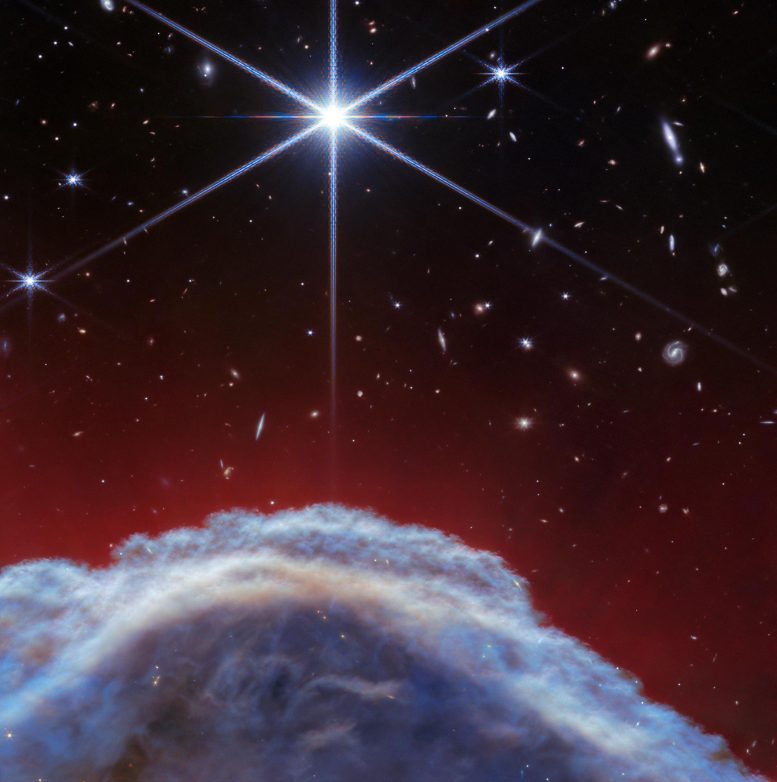
This image of the Horsehead Nebula from NASA’s James Webb Space Telescope focuses on a portion of the horse’s “mane” that is about 0.8 light-years in width. It was taken with Webb’s NIRCam (Near-infrared Camera). The ethereal clouds that appear blue at the bottom of the image are filled with a variety of materials including hydrogen, methane, and water ice. Red-colored wisps extending above the main nebula represent both atomic and molecular hydrogen. In this area, known as a photodissociation region, ultraviolet light from nearby young, massive stars creates a mostly neutral, warm area of gas and dust between the fully ionized gas above and the nebula below. As with many Webb images, distant galaxies are sprinkled in the background.
This image is composed of light at wavelengths of 1.4 and 2.5 microns (represented in blue), 3.0 and 3.23 microns (cyan), 3.35 microns (green), 4.3 microns (yellow), and 4.7 and 4.05 microns (red).
Credit: NASA, ESA, CSA, Karl Misselt (University of Arizona), Alain Abergel (IAS, CNRS)
Webb’s new view focuses on the illuminated edge of the nebula’s distinctive structure.
The Horsehead Nebula is prancing across the cosmic stage in new infrared views from NASA’s James Webb Space Telescope. Extreme close-ups of the horse’s “mane” from Webb’s Near-Infrared Camera (NIRCam) and Mid-Infrared Instrument (MIRI) showcase a dynamic region that transitions from a mostly neutral, warm area of gas and dust within the nebula (represented in blue) to surrounding hot, ionized gas (red). Webb’s observations will allow astronomers to investigate how dust in the nebula blocks and emits light, and to better understand the nebula’s shape.
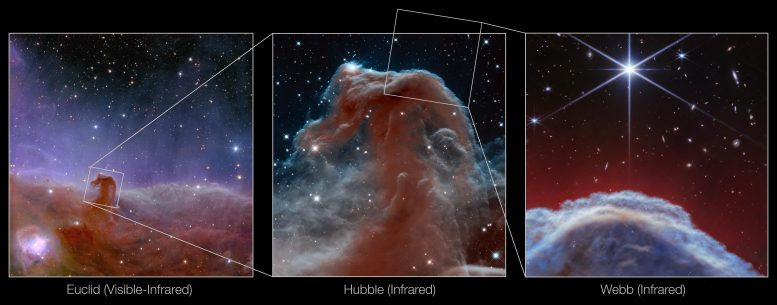
This image showcases three views of one of the most distinctive objects in our skies, the Horsehead Nebula. The first image (left), released in November 2023, features the Horsehead Nebula as seen in visible light by ESA’s Euclid telescope. The second image (middle) shows a view of the Horsehead Nebula in near-infrared light from NASA’s Hubble Space Telescope, which was featured as the telescope’s 23rd anniversary image in 2013. This image reveals a beautiful, delicate structure that is normally obscured by dust. The third image (right) features a new view of the Horsehead Nebula from NASA’s James Webb Space Telescope’s NIRCam (Near-Infrared Camera) instrument.
Credit: NASA, ESA, CSA, Karl Misselt (University of Arizona), Alain Abergel (IAS, CNRS), Mahdi Zamani The Euclid Consortium, Hubble Heritage Project (STScI, AURA)
Webb Space Telescope Captures Top of Iconic Horsehead Nebula in Unprecedented Detail
NASA’s James Webb Space Telescope has captured the sharpest infrared images to date of a zoomed-in portion of one of the most distinctive objects in our skies, the Horsehead Nebula. These observations show the top of the “horse’s mane” or edge of this iconic nebula in a whole new light, capturing the region’s complexity with unprecedented spatial resolution.
Webb’s new images show part of the sky in the constellation Orion (The Hunter), in the western side of a dense region known as the Orion B molecular cloud. Rising from turbulent waves of dust and gas is the Horsehead Nebula, otherwise known as Barnard 33, which resides roughly 1,300 light-years away.
The nebula formed from a collapsing interstellar cloud of material, and glows because it is illuminated by a nearby hot star. The gas clouds surrounding the Horsehead have already dissipated, but the jutting pillar is made of thick clumps of material and therefore is harder to erode. Astronomers estimate that the Horsehead has about five million years left before it too disintegrates. Webb’s new view focuses on the illuminated edge of the top of the nebula’s distinctive dust and gas structure.
The Horsehead Nebula is a well-known photodissociation region, or PDR. In such a region, ultraviolet (UV) light from young, massive stars creates a mostly neutral, warm area of gas and dust between the fully ionized gas surrounding the massive stars and the clouds in which they are born. This UV radiation strongly influences the chemistry of these regions and acts as a significant source of heat.
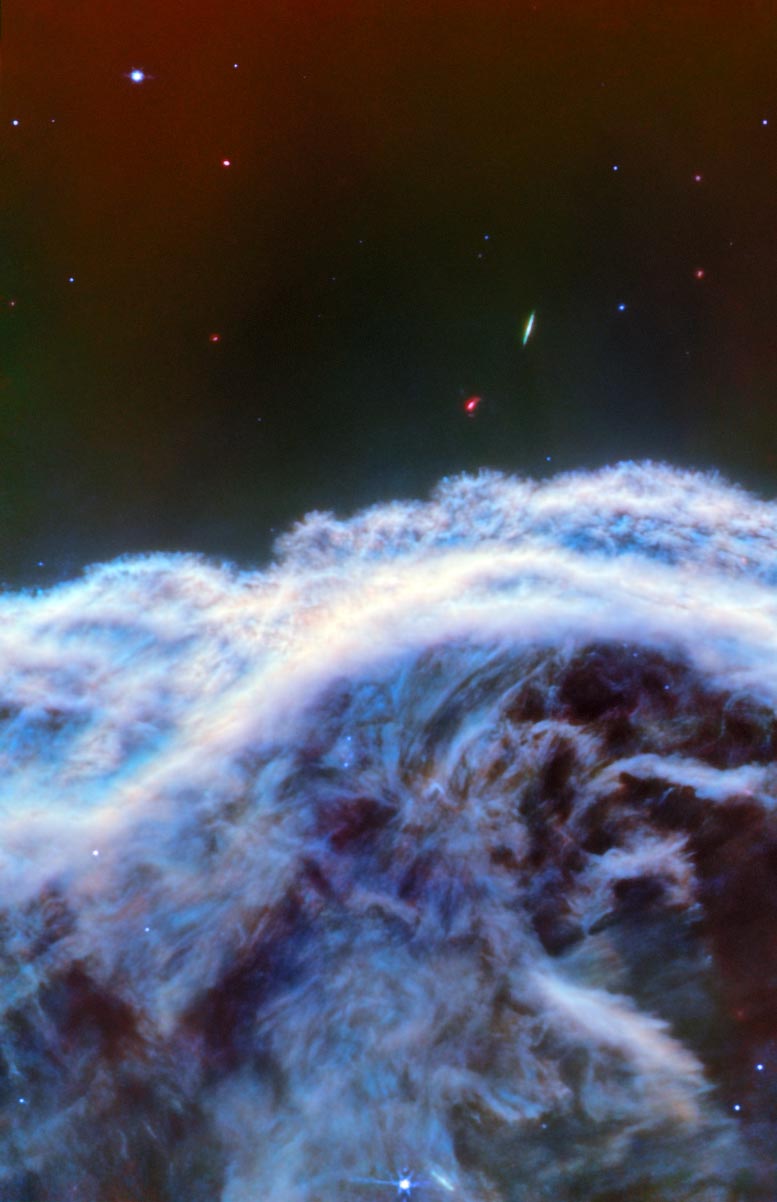
This image of the Horsehead Nebula from NASA’s James Webb Space Telescope focuses on a portion of the horse’s “mane.” It was taken with Webb’s MIRI (Mid-Infrared Instrument). Mid-infrared light captures the glow of substances like dusty silicates and soot-like molecules called polycyclic aromatic hydrocarbons. Credit: NASA, ESA, CSA, Karl Misselt (University of Arizona), Alain Abergel (IAS, CNRS)
These regions occur where interstellar gas is dense enough to remain mostly neutral, but not dense enough to prevent the penetration of UV light from massive stars. The light emitted from such PDRs provides a unique tool to study the physical and chemical processes that drive the evolution of interstellar matter in our galaxy, and throughout the universe from the early era of vigorous star formation to the present day.
Due to its proximity and its nearly edge-on geometry, the Horsehead Nebula is an ideal target for astronomers to study the physical structures of PDRs and the molecular evolution of the gas and dust within their respective environments, and the transition regions between them. It is considered one of the best regions in the sky to study how radiation interacts with interstellar matter.
Thanks to Webb’s MIRI and NIRCam instruments, an international team of astronomers has revealed for the first time the small-scale structures of the illuminated edge of the Horsehead. As UV light evaporates the dust cloud, dust particles are swept out away from the cloud, carried with the heated gas. Webb has detected a network of thin features tracing this movement. The observations have also allowed astronomers to investigate how the dust blocks and emits light, and to better understand the multidimensional shape of the nebula.
Next, astronomers intend to study the spectroscopic data that have been obtained to gain insights into the evolution of the physical and chemical properties of the material observed across the nebula.
These observations were taken for the Webb GTO program 1192 and the results were published on April 29 in Astronomy & Astrophysics.
Reference: “JWST observations of the Horsehead photon-dominated region I. First results from multi-band near- and mid-infrared imaging” by A. Abergel, K. Misselt, K.D. Gordon, A. Noriega-Crespo, P. Guillard, D. Van De Putte, A.N. Witt, N. Ysard, M. Baes, H. Beuther, P. Bouchet, B.R. Brandl, M. Elyajouri, O. Kannavou, S. Kendrew, P. Klassen and B. Trahin, 22 April 2024, Astronomy & Astrophysics.
DOI: 10.1051/0004-6361/202449198
The James Webb Space Telescope is the world’s premier space science observatory. Webb is solving mysteries in our solar system, looking beyond to distant worlds around other stars, and probing the mysterious structures and origins of our universe and our place in it. Webb is an international program led by NASA with its partners, ESA (European Space Agency) and the Canadian Space Agency.






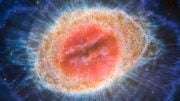
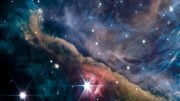

What an amazing image, such wonderful detail. And those ultra distant galaxies in the background show just how patchy and sharply delineated those gas and dusty nebulae can be.